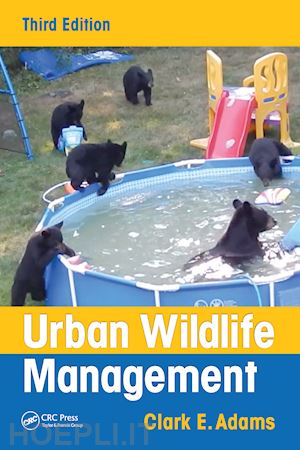Introduction: A New Wildlife Management ParadigmA Snapshot of the Urban Wildlife Management LandscapeChanging Wildlife ValuesThe Need for a Comprehensive Treatment of Urban Wildlife ManagementUnderstanding and Meeting the Future Challenges of Wildlife ManagementLiterature Review LimitationsNature in Human-Dominated LandscapesChapter ActivitiesCase Study I.1: Literature Review on Urban Deer ResearchSidebar I.1: Wildlife Hotline QuizSidebar I.2: Job Description of an Urban Wildlife BiologistAppendix I.1: Answers to Wildlife Hotline QuizHUMAN–WILDLIFE INTERFACEWildlife Management: Past and PresentKey ConceptsBrief History of Wildlife Management in North AmericaRise the American Conservation MovementDemographic Factors That Set the Stages for Urban Wildlife ManagementSeparation of People and NatureReconnecting People and NatureA New Kind of WildlifeChapter ActivitiesSpecies Profile: Killdeer (Charadrius vociferous)Perspective Essay 1.1: Human–Wildlife Interactions in the 1950sPerspective Essay 1.2: Human–Wildlife Interactions in the 1970sPrincipal Components of Urban Wildlife ManagementKey ConceptsIntroductionUrban Habitats as a Dominant Focus of Wildlife ProfessionalsNeed for Wildlife Management in Urban AreasTraditional and Alternative Methods of Human–Wildlife Conflict ManagementNeed for Public Education Programs about Urban Wildlife, Management, and HabitatsAlternative Curriculums to Train Urban Wildlife BiologistsWildlife Management Research AgendaNaturalist and Natural HistoryInfrastructure for Urban Wildlife Management Is MissingChapter ActivitiesCase Study 2.1: Neighborhood Moose Killed by KindnessPerspective Essay 2.1: The Texas Master Naturalist ProgramSpecies Profile: Bobcat (Lynx rufus)AppendixAppendix 2.1: Numbers of Amphibian, Reptile, Bird, and Mammalian Species by StateAppendix 2.2: Amphibians, Reptiles, Birds, and Mammals Reported as Intakes at 17 Animal Rehabilitation Centers Throughout the United StatesURBAN ECOSYSTEMSEcological Principles in an Urban ContextKey ConceptsUrban ContextEcological PrinciplesEcosystem StructureFood Chains and WebsSymbiotic RelationshipsBiotic CommunitiesEcosystem FunctionEcosystem ServicesEcology of Urban EcosystemsEven a Peanut Butter Sandwich Has Profound Environmental ImpactsChapter ActivitiesSpecies Profile: Chimney Swift (Chaetura pelagica)Urban SoilsKey ConceptsIntroductionSoil FormationSoil StructureSoil HorizonsSoil FunctionsSoil Biota and Their FunctionsImpacts of Urbanization on Soil Structure and FunctionTaking Better Care of Urban SoilUrban Wildlife Management ImplicationsChapter ActivitiesSpecies Profile: Moles (Talpidae sp.)Perspective Essay 4.1: Darwin’s EarthwormsPerspective Essay 4.2: Home Composting on a Small ScaleUrban Aquatic SystemsKey ConceptsIntroductionFlow of Water through an Urban CommunityWater Cycle: Nature’s FilterCaring for the Water CycleRiparian Corridors: Streams and RiversUrban Stream SyndromeAquatic Food ChainStructural and Functional Adaptations of FishesFish as Indicator SpeciesInvasive and Introduced SpeciesRestoration of Riparian HabitatsUrban WetlandsUrban (Community) Fisheries ProgramsChapter ActivitiesCase Study 5.1: Controlling Exotic Flora with Exotic FaunaSpecies Profile: American Beaver (Castor canadensis)Population DynamicsKey ConceptsIntroductionSurvivalAdaptationsDensityFactors Affecting Population DensitiesHow Populations GrowPopulation Growth Rate PatternsEffects of Habitat Fragmentation on Population DynamicsEffects of Supplemental Feeding on Population DynamicsEffects of Animal Damage Control Activities on Population DynamicsEffects of Environmental Pollutants on Wildlife Population DynamicsChapter ActivitySpecies Profile: Tree Squirrels (Sciurus spp.)URBAN HABITATS AND HAZARDSUrban Green SpacesKey ConceptsIntroductionGreen SpacesRemnant Habitat PatchesSuccessional Habitat PatchesManaged Habitat PatchesChapter ActivitiesPerspective Essay 7.1: Birds in Texas CemeteriesPerspective Essay 7.2: For the Love of LawnsSpecies Profile: Red Fox (Vulpes vulpes)Urban Gray SpacesKey ConceptsIntroductionBuildings, Windows, and TowersRoads and HighwaysBridges, Birds, and BatsLandfills, Dumpsters, and Garbage CansAirportsChapter ActivitiesSpecies Profile: Mexican Free-Tailed Bat (Tadarida brasiliensis)URBAN WILDLIFE SPECIESUrban Herpetofauna (Amphibians and Reptiles)Key ConceptsIntroductionAmphibiansReptilesChapter ActivitiesSpecies Profile 9.1: Gray Tree Frog (Hyla versicolor)Species Profile 9.2: Green Anole (Anolis carolinensis)Appendix 9.1: State Totals of Amphibians and Reptiles and Numbers of Each Class Observed in Urban CommunitiesUrban BirdsKey ConceptsIntroductionClass Aves Taxonomy of Living Orders in the United StatesDistinguishing Characteristics and Life CycleManagement for Birds in Urban HabitatsNational Distribution by StatesUrban ObservationsChapter ActivitiesSpecies Profile: Common Poorwill (Chordeiles minor)Appendix 10.1: State Totals of Birds and Numbers of Each Species Observed in Urban Communities Somewhere in the United StatesUrban MammalsKey ConceptsIntroductionClass Mammalia TaxonomyDistinguishing Characteristics and Life CycleManagement for Mammals in Urban HabitatsNational Distribution by StatesUrban ObservationsUrban Raccoons (Procyon lotor)Urban Coyotes (Canis latrans)Chapter ActivitiesSpecies Profile: California Sea Lion (Zalophus californianus)Appendix 11.1: State Totals of Mammals and Numbers of Each Species Observed in Urban Communities Somewhere in the United StatesUrban Threatened, Endangered, and Extirpated SpeciesKey ConceptsIntroductionDiversity of T/E SpeciesChapter ActivitiesUrban Introduced and Invasive SpeciesKey ConceptsIntroductionIntroduced SpeciesInvasive and Feral Species IntroductionsCase Studies of Invasive SpeciesCase Studies of Feral SpeciesInvasive Species Management PlansChapter ActivitiesSpecies Profile: Monk Parakeet (Myiopsitta monachus)Resident Canada Geese and Urban White-Tailed DeerKey ConceptsIntroductionFactors That Contributed to Geese and Deer Abundance in Urban AmericaExtent of the Problem: A National AssessmentDistribution of Resident Canada Geese and White-Tailed Deer in the Continental United StatesHuman Response to Resident Canada Geese and Urban White-Tailed DeerEcological Impacts of Resident Canada Geese and Urban White-Tailed DeerHealth and Safety IssuesManagement Strategies for Overabundant Resident Canada Geese and Urban White-Tailed Deer PopulationsChapter ActivityCase Study 14.1: A Tale of Two CitiesURBAN SOCIOPOLITICAL LANDSCAPEHuman Dimensions of Urban Wildlife ManagementKey ConceptsIntroductionThe "People Factor"Conducting Human Dimensions ResearchSurveying Wildlife RecreationistsRole of Human Dimensions in Urban Wildlife ManagementWorking with Urban StakeholdersChapter ActivitiesPerspective Essay 15.1: Urbanites’ Fear of the Natural World around ThemCase Study 15.1: Stakeholders Disagree on Best Approach for Managing Fallow DeerLegal Aspects of Urban Wildlife ManagementKey ConceptsWildlife Law 101Federal LawsState LawsCounty and Municipal LawsLocal OrdinancesWho’s in Charge Here?Chapter ActivitiesSidebar 16.1: New Berlin vs. HagarSidebar 16.2: Urban Wildlife Damage PrinciplesSpecies Profile: Cattle Egret (Bubulcus ibis)Zoonoses and Management ConsiderationsKey ConceptsWhat Are Zoonoses?Wildlife and Weaponization of Zoonotic DiseasesParasitic DiseasesMycotic DiseasesBacterial DiseasesViral DiseasesPrion DiseasesChapter ActivitiesSpecies Profile: American Robin (Turdus migratorius)Appendix: Lists of Terrestrial Amphibians, Reptiles, Birds, and Mammals by States and Those Observed in Urbanized Communities in the United StatesAmphibiansReptilesBirdsMammalsSources of Information on National, State, and Urban Lists of Amphibians, Reptiles, Birds, and MammalsReferences












